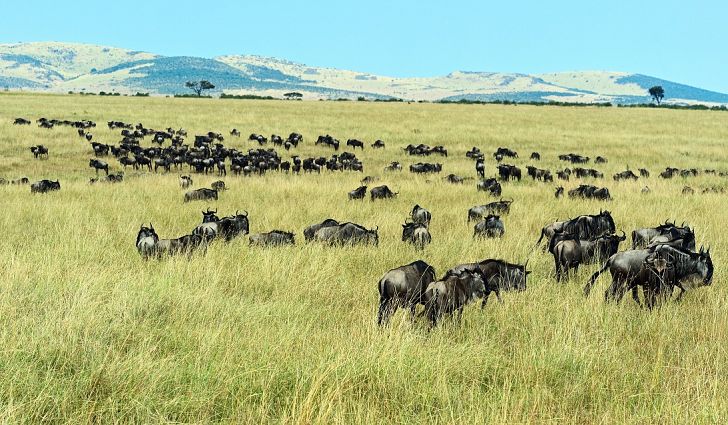
The annual wildebeest migration of herds in northern Tanzania and Kenya is one of the world's most spectacular wildlife events. Often referred to as the 'Greatest Show on Earth', The Great Wildebeest Migration is a movement of approximately two to two and a half million wildebeest, zebra and gazelle throughout the Serengeti and Masai Mara ecosystems.
Maps and illustrations showing the path of the migrating herds should be used as a general guide and a good way to choose the location of your hotel, camp or lodge. However, as with anything in nature, the actual day to day pattern is unpredictable. Wildebeest are remarkably unpredictable!
If your wish is to safari at the heart of The Great Wildebeest Migration, it is advisable to book one of the Serengeti's famous mobile camps. Two in particular set themselves apart from the others for their commitment to keeping up with the herds - Nomad Tanzania's Serengeti Safari Camp and & Beyond's Serengeti Under Canvas. These are the two mobile operations which we consider truly mobile and will be located near or amongst the herds at any time of the year. There are then the mobile camps of Alex Walker's Serian and Asilia's Olakira which offer superb mobile operations from July to November and also from December through to March. For the rest of the year these two fabulous camps are closed.
If going mobile is a little too adventurous for you, then choosing one of the Serengeti's permanent lodges is the best way to have all the comfort you need and also a good location for the herds on your Love Birds Adventure and Safaris. Below is an overview of the movement of the herds, where we also give the names of the best permanent lodges to stay in during that time of year.
A general guide to the Wildebeest migration
The Southern Serengeti's huge grass plains extend into the Ngorongoro Conservation Area. From December to March the Great Migration congregates around Lake Ndutu in the Ngorongoro Conservation Area. When it reaches the area the herd splits up and spreads out leaving wildebeest herds as far as the eye can see. Ndutu Lodge and Kusini are the only permanent lodges in the area. Kusini is best towards the end of the period whereas Ndutu Lodge for its entirety. Asilia's Dunia Camp is also a good option at the beginning of December and again when the herds push North in March.
From April to May, the Wildebeest migration moves north into the plains of the southern Serengeti with front runners stretching out to the Western Corridor and centre of the park at Seronera. Asilia's Dunia Camp is a great option for this time as are any of the central Serengeti hotels such as the Serena or Sopa. Early herds may well have pushed up to the Grumeti River Camp, Kirawira and Mbalageti Lodge area of the Western Corridor.
At the end of May there are wildebeest herds spread from the Western corridor through the heart of the park. One group tends to head West into the Western Corridor and crosses the Grumeti River before leaving the park and entering the exclusive Singita Grumeti Reserves. This herd will then head up through the Ikorongo game reserve on the Serengeti's Western corridor before the front runners arrive into the Kogatende area in July. The other herds head directly to the north of the Serengeti, passing straight up the middle through Seronera, Lobo and up to the Bologonja river area near the Eastern border with the Loliondo reserve at Kleins. It is true to say that at this time herds can be anywhere from the Western corridor through to the Eastern side of the park. Splinter herds will break from the main herds, covering huge areas in their search for fresh grasses. We would recommend Grumeti River Camp, Faru Faru, Sasakwa, Sabora, Mbalageti Lodge and Kirawira for the Western corridor, whereas some herds will have pushed up as far as Migration camp in the Northern Lobo area. Late July will see any of the Kogatende permanent lodges having good herds - Serengeti Lamai and Sayari Camp being the places to go towards the end of July.
From August through to October the herds are in the Northern Serengeti at Kogatende as well as in Kenya’s Masai Mara. River crossings often happen daily here with Kogatende being an exceptional location to its vastly lower numbers than the Mara. Given that the herds are simply following local rainfall, some move north, some move south… and many move in both directions in the same day. The sprawling ball moves in a circular fashion throughout these months – it is a fantastic time of year to see the herds.
In late October and November the herds start their second ‘Great Migration’ South towards the fertile lands of the Ndutu plains where the rains will have rejuvenated the grasses. This is a fairly difficult time to catch the mega hard as they move vast distances every day.
But by the beginning of December, Ndutu starts seeing the herds return to calve, and for the whole process to start all over again.
With all this said…..wildebeest are not exactly the most predictable of animals! The Migration is dependant upon rain with the herds constantly searching for fresh grasses. As a result, it is a challenge to predict where best to stay. Our migration map is a great indicator of what the herds are ‘supposed’ to do throughout the year. Choosing a camp on your Love Birds Adventure and Safaris that is located in the right area at the right time of year will clearly increase your chances, but the best way to try and catch the herds is to stay in the Serengeti’s famous mobile camps – which move with the herds.